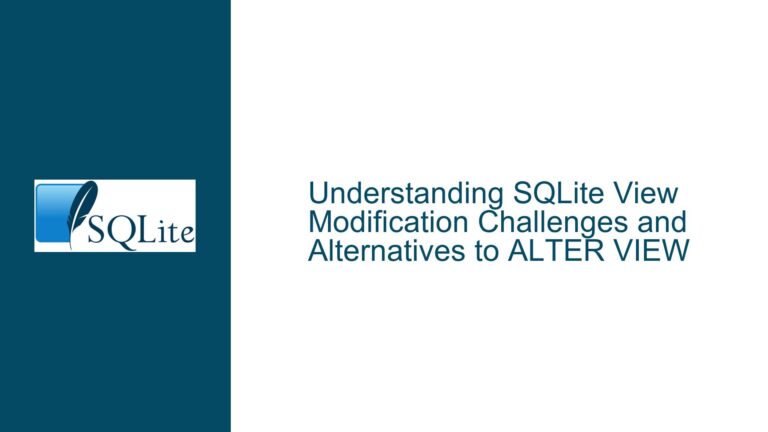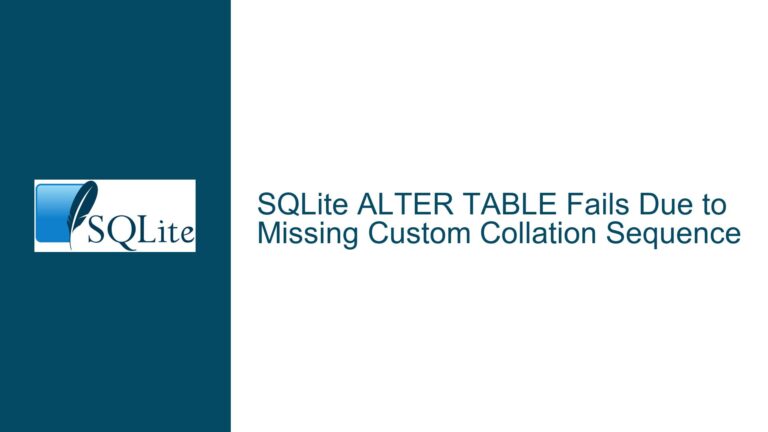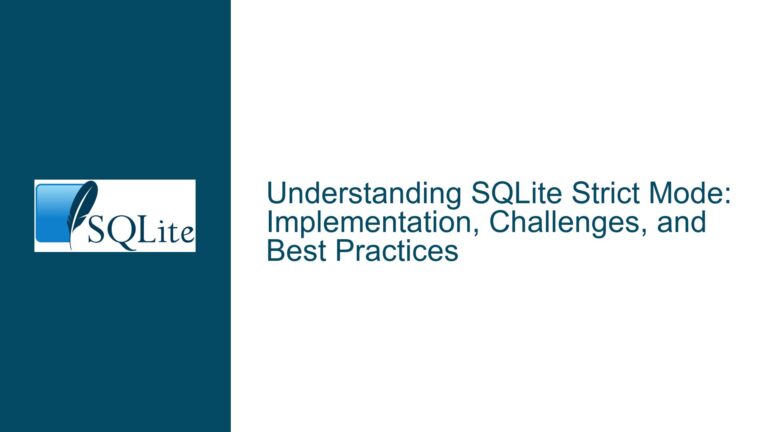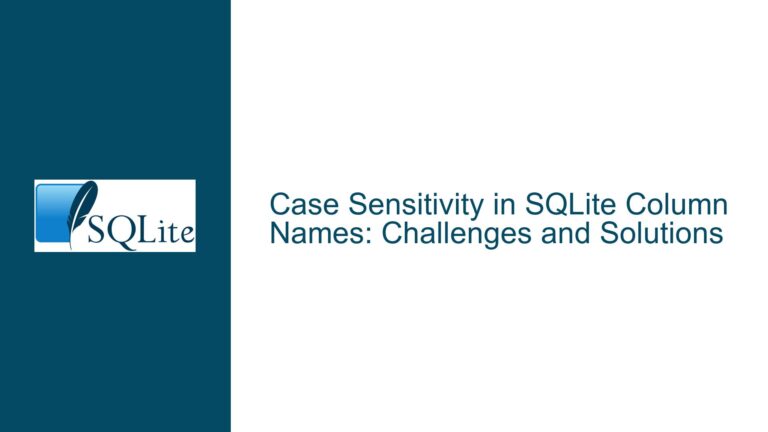Distinguishing CREATE TABLE “Already Exists” Errors in SQLite
Understanding the Need to Detect Table Existence During Creation Failures
The core challenge revolves around programmatically determining whether a CREATE TABLE operation failed due to the table already existing versus other errors (e.g., syntax errors, permission issues, or database corruption). This distinction is critical for applications that require precise control over schema initialization sequences, particularly when multiple processes or threads might attempt concurrent schema modifications. The absence of a dedicated extended result code for "table already exists" forces developers to rely on fragile error message parsing or additional schema introspection queries, both of which introduce trade-offs in performance, reliability, and concurrency safety.
SQLite returns SQLITE_ERROR (generic error code 1) for CREATE TABLE failures caused by existing tables. While the human-readable error message from sqlite3_errmsg() contains phrases like "already exists," relying on this text introduces versioning risks (message wording changes) and localization issues (translated messages). The discussion highlights two fundamental requirements:
- Atomicity in schema verification – Determining table existence during the creation attempt without separate pre-check queries
- Concurrency safety – Avoiding race conditions when multiple processes attempt to create the same table simultaneously
These requirements collide with SQLite’s error reporting design, which prioritizes simplicity and backward compatibility over granular error categorization. Extended result codes like SQLITE_ERROR_ALREADY_EXISTS do not exist for schema operations, forcing developers to choose between error message parsing (with inherent fragility) or additional schema inspection steps (with performance overhead).
Why SQLite Lacks Granular Error Codes for Schema Conflicts
The absence of extended result codes for common schema conflicts stems from SQLite’s design philosophy and operational constraints:
1. Stability Guarantees
SQLite maintains strict backward compatibility for its C API and error codes. Introducing new extended result codes risks breaking existing applications that assume a fixed set of error conditions. For example, if an application checks for SQLITE_ERROR without masking extended codes, a new SQLITE_ERROR_ALREADY_EXISTS code would bypass their error handling logic.
2. Error Message Abstraction Layer
Human-readable error messages are intentionally decoupled from machine-readable error codes. This allows SQLite to improve clarity in diagnostics without altering programmatic interfaces. However, it shifts the burden of error categorization to developers when specific failure modes require different handling.
3. Multi-Process Concurrency Model
SQLite assumes cooperative concurrency control through proper locking (e.g., BEGIN IMMEDIATE transactions). Fine-grained error codes for schema conflicts could encourage race condition-prone designs where applications reactively handle errors instead of proactively coordinating schema changes.
4. Schema Introspection Capabilities
The availability of metadata queries (e.g., PRAGMA table_list, sqlite_master table) reduces the need for specialized error codes. Developers can explicitly check table existence before creation attempts, though this requires additional round-trips to the database.
5. Transactional Atomicity Boundaries
SQLite’s transactional model ensures that schema changes are atomic at the transaction level. Providing per-statement error granularity for schema operations would complicate the atomicity guarantees, especially when multiple schema changes occur within a single transaction.
These factors collectively explain why SQLite does not provide extended result codes for schema existence errors. The workarounds involve either embracing schema introspection or carefully parsing error messages while accounting for localization and versioning risks.
Reliable Methods to Detect Table Existence Without Error Message Parsing
Method 1: Pre-Check Table Existence with Schema Queries
Step 1: Query sqlite_master for Table Metadata
Execute a parameterized query against the sqlite_master table to check for the table’s existence:
SELECT 1 FROM sqlite_master WHERE type='table' AND name=?;
Bind the table name as a parameter to avoid SQL injection. A non-empty result indicates the table exists.
Step 2: Conditional Table Creation
Use CREATE TABLE IF NOT EXISTS to avoid redundant errors:
CREATE TABLE IF NOT EXISTS my_table (...);
Step 3: Determine Creation Outcome
After executing the CREATE TABLE statement:
- If the
sqlite_masterquery from Step 1 returned no rows and theCREATE TABLEsucceeded, the table was newly created. - If the
sqlite_masterquery returned rows, the table pre-existed. - If the
CREATE TABLEfailed despitesqlite_masterindicating absence, handle other errors viasqlite3_errcode().
Concurrency Considerations
Wrap both steps in an BEGIN IMMEDIATE transaction to prevent race conditions:
BEGIN IMMEDIATE;
SELECT 1 FROM sqlite_master WHERE type='table' AND name=?;
CREATE TABLE IF NOT EXISTS my_table (...);
COMMIT;
This ensures atomicity: the transaction lock prevents concurrent processes from modifying sqlite_master between the check and the creation.
Method 2: Post-Creation Metadata Validation
Step 1: Attempt Table Creation Without Existence Checks
Execute a standard CREATE TABLE statement (without IF NOT EXISTS):
CREATE TABLE my_table (...);
Step 2: Handle Errors and Validate Schema
If sqlite3_step() returns SQLITE_ERROR:
- Call
sqlite3_table_column_metadata()to check if the table now exists:
int rc = sqlite3_table_column_metadata(
db, "main", "my_table", NULL, NULL, NULL, NULL, NULL, NULL
);
- If
rc == SQLITE_OK, the table was created by a concurrent process after the initial failure. - If
rc == SQLITE_ERROR, the failure was due to other reasons (e.g., syntax error).
Step 3: Fallback to sqlite_master Query
If the metadata API is unavailable (e.g., older SQLite versions), query sqlite_master after the creation failure:
SELECT 1 FROM sqlite_master WHERE type='table' AND name='my_table';
A non-empty result indicates the table exists (possibly created by another process).
Performance Optimization
Cache the table existence state locally after the initial check to avoid redundant queries in high-usage scenarios.
Method 3: Leveraging table_list PRAGMA for Schema Inspection
Step 1: Use PRAGMA table_list for Existence Check
Execute a pragma statement to check for the table:
PRAGMA table_list(my_table);
In C code, use sqlite3_prepare_v2() and check if a row is returned.
Step 2: Combine with Transactional Creation
sqlite3_exec(db, "BEGIN IMMEDIATE;", 0, 0, 0);
// Check PRAGMA table_list
if (table_does_not_exist) {
sqlite3_exec(db, "CREATE TABLE my_table (...);", 0, 0, &errmsg);
}
sqlite3_exec(db, "COMMIT;", 0, 0, 0);
Step 3: Handle Commit Failures
If the COMMIT fails, retry the entire sequence to handle transient lock conflicts.
Advantages Over sqlite_master
PRAGMA table_list provides richer metadata (e.g., schema name, table type) and avoids direct interaction with internal system tables.
Method 4: Error Message Parsing with Version Safeguards
Step 1: Attempt Table Creation
Execute CREATE TABLE without existence checks and capture the error message.
Step 2: Parse Error Message with Caution
In C:
const char *errmsg = sqlite3_errmsg(db);
if (strstr(errmsg, "already exists") != NULL) {
// Handle existing table
} else {
// Handle other errors
}
Step 3: Mitigate Localization Risks
- Set the error message language to English using
sqlite3_config(SQLITE_CONFIG_LOG, ...)before opening the database. - Verify SQLite version at runtime to guard against message changes:
if (sqlite3_libversion_num() < 3034000) {
// Use legacy error message parsing
} else {
// Use updated parsing logic
}
Step 4: Fallback to Schema Query
If error message parsing fails (unexpected message format), execute a sqlite_master query to resolve ambiguity.
Method 5: Combining CREATE TABLE IF NOT EXISTS with Triggered Initialization
Step 1: Create Table with Default Data Trigger
CREATE TABLE IF NOT EXISTS my_table (...);
CREATE TRIGGER IF NOT EXISTS init_my_table
AFTER INSERT ON my_table
WHEN (SELECT COUNT(*) FROM my_table) = 0
BEGIN
INSERT INTO my_table DEFAULT VALUES;
END;
Step 2: Insert Dummy Row to Activate Trigger
INSERT INTO my_table DEFAULT VALUES;
Step 3: Remove Dummy Row After Initialization
DELETE FROM my_table WHERE ...; -- Identify dummy row
Concurrency Handling
Wrap the insertion in a transaction to ensure only one process initializes the table:
BEGIN IMMEDIATE;
INSERT INTO my_table DEFAULT VALUES;
COMMIT;
This approach leverages SQLite’s atomic write operations to ensure initialization occurs exactly once, regardless of how many processes attempt it.
Final Recommendations
Prefer Transactional Schema Checks
UseBEGIN IMMEDIATEcombined withPRAGMA table_listorsqlite_masterqueries to avoid race conditions. This minimizes redundant SQL operations while ensuring reliability.Avoid Error Message Parsing in Production Code
Reserve message parsing for debugging or legacy environments where schema introspection is unavailable.Use
CREATE TABLE IF NOT EXISTSwith Post-Creation Validation
Even if the table exists, validate its schema (column names, types) to handle edge cases where a pre-existing table has an incompatible structure.Benchmark Performance Trade-Offs
Measure the overhead of additional schema queries versus error handling in high-concurrency scenarios. Often, transactional checks add negligible latency compared to I/O-bound table creation.
By combining these techniques, developers can robustly distinguish "table already exists" errors without relying on fragile error message parsing or sacrificing concurrency safety.






